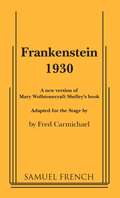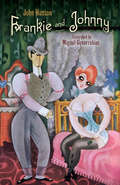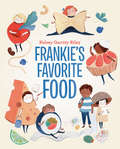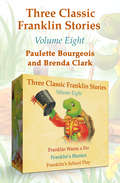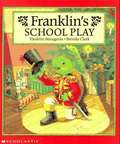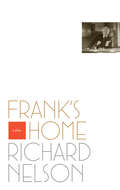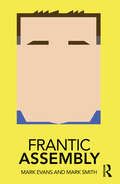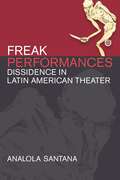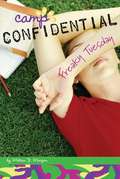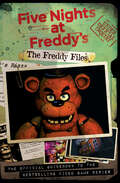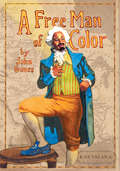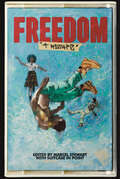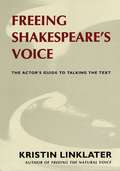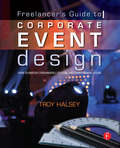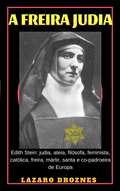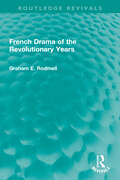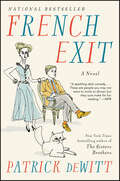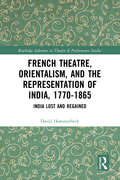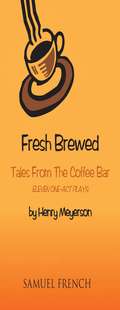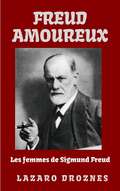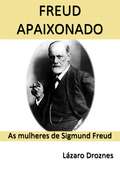- Table View
- List View
Frankenstein 1930
by Fred CarmichaelThriller / 7m, 6f / Harking back to the original concept of Frankenstein, this version amplifies the film's suspenseful horror and adds greater depth of character and motivation as well as a new and different love story. All of the eagerly anticipated elements are here: the stone walled laboratory, the crazed scientist, angry villagers, a swooning heroine, a fearful storm and the hideous yet pathetic, deadly creature with its confused mind and powerful, undisciplined body. The final confrontation between the doctor and the creature produces a startling surprise. "A genuine thriller.... Memorable entertainment." Gainville News. "Will give you a full measure of thrills and laughs ... [with] ever increasing suspense." Glens Falls Post Star. "Pure gold.... You'll have to go a long way to find a better play." Greenwich Journal.
Frankie and Johnny
by John Huston Miguel CovarrubiasThe ill-fated lovers Frankie and Johnny were already legends by 1930, the year of this illustrated drama's publication. The unique interpretation is a collaboration between John Huston, the future director of The Maltese Falcon and other film classics, and Miguel Covarrubias, an influential painter and caricaturist. Huston, who reputedly interviewed a neighbor of the real-life Frankie and Johnny, was inspired to adapt the tale of love gone wrong for a puppet show for which George Gershwin supplied musical accompaniment. In addition to Huston's script and distinctive images by Covarrubias, this edition features the "Saint Louis Version" of the folktale, regarded as the most authentic version, as well as 20 variations on the story and song.
Frankie's Favorite Food
by Kelsey Garrity-RileyA scrumptiously adorable story about a boy, a school play and his love for food. Featuring foods from all over the world, this debut picture book will make you hungry for more!Frankie has a problem: he has too many favorite foods. He can't bring himself to choose just one to be for the school play, so on the day of the performance, he's still without a costume. His teacher comes up with a delicious idea: what if Frankie becomes the Costume Manager? That way, he can parlay his love of all things culinary into the whole production. From adding some last-minute garnishes to helping the rice and beans into their costumes, Frankie shines backstage until he has a brilliant idea and decides to make his debut on the menu as something that combines his love for all his favorite foods . . .In this funny and scrumptiously adorable story, readers will delight in the variety of foods represented and the clever performances full of silly word play and sweet camaraderie. In Kelsey Garrity-Riley's author-illustrator debut, she shows the joy of food and revels in celebrating the way food can bring people together and inspire creativity.
Franklin Wants a Pet, Franklin's Blanket, and Franklin's School Play: Franklin Wants a Pet, Franklin's Blanket, and Franklin's School Play (Classic Franklin Stories)
by Paulette Bourgeois Brenda ClarkFranklin Wants a Pet In this Franklin Classic Storybook, Franklin can count forwards and backwards. He can zip zippers and button buttons. He can slide down a riverbank by himself. He can even sleep alone in his small, dark shell. And ever since he was small, he really wanted a pet. Franklin’s Blanket In this Franklin Classic Storybook, our hero can’t go to sleep without his favorite blue blanket. One night he can’t find his tattered old blanket and must try to get along without it. Franklin’s School Play In this Franklin Classic Storybook, Franklin has been chosen to play the Nutcracker Prince in his class’s production. But will he be too nervous to say his lines when the big night arrives?
Franklin's School Play
by Paulette BourgeoisFranklin has a big role in the school play. But he is so nervous he keeps forgetting his lines. How will Franklin learn to get over his stage fright?
Frank's Home
by Richard Nelson"A thoroughly invigorating, tightly focused piece of Chekhovian drama, wherein chatter about work and art . . . fail to mask deep vulnerability."-Chicago TribuneA play about Frank Lloyd Wright set in the summer of 1923, when the great architect has recently left Chicago for California, hoping to mend his relationship with his adult children. Richard Nelson brings to life two great architectural demigods, Wright and Louis Sullivan, only to show their all-too-human frailties.Richard Nelson's plays include Rodney's Wife, Goodnight Children Everywhere, Some Americans Abroad, Franny's Way, New England, and James Joyce's The Dead (with Shaun Davey), winner of the Tony Award for Best Book of a Musical.
Frantic Assembly (Routledge Performance Practitioners)
by Mark Evans Mark SmithFrantic Assembly have had a powerful and continuing influence on the popularisation of devising practices in contemporary theatre-making. Their work blends brave and bold physical theatre with exciting new writing, and they have collaborated with some of the leading theatre-makers in the UK. The company’s impact reaches throughout the world, particularly through their extensive workshop and education programmes, as well as their individual and collective impact as movement directors on landmark, internationally successful productions such as Black Watch and The Curious Incident of the Dog in the Night-Time. This volume reveals the background to, and work of, a major influence on twentieth and twenty-first century performance. Frantic Assembly is the first book to combine: an overview of the history of the company since its foundation in 1994 an analysis of the key ideas underpinning the company’s work a critical commentary on two key productions – Hymns by Chris O’Connell (1999) and Stockholm by Bryony Lavery (2007) a detailed description of a Frantic Assembly workshop, offering an introduction to how the company works. As a first step towards critical understanding, and as an initial exploration before going on to further, primary research, Routledge Performance Practitioners offer unbeatable value for today’s student.
Freak Performances: Dissidence in Latin American Theater
by Analola SantanaThe figure of the freak as perceived by the Western gaze has always been a part of the Latin American imaginary, from the letters that Columbus wrote about his encounters with dog-faced people to Shakespeare's Caliban. The freak acquires greater significance in a globalized, neoliberal world that defines the "abnormal" as one who does not conform mentally, physically, or emotionally and is unable or unwilling to follow the economic and cultural norms of the institutions in power. Freak Performances examines the continuing effects of colonialism on modern Latin American identities, with a particular focus on the way it has constructed the body of the other through performance. Theater questions the representations of these bodies, as it enables the empowerment of the silenced other; the freak as a spectacle of otherness finds in performance an opportunity for re-appropriation by artists resisting the dominant authority. Through an analysis of experimental theater, dance theater, performance art, and gallery-based installation art across eight countries, Analola Santana explores the theoretical issues shaped by the encounters and negotiations between different bodies in the current Latin American landscape.
Freaky Tuesday (Camp Confidential #17)
by Melissa J. MorganBrynn's just transferred to a brand-new school in a town close by. A town in Bizarro World, that is, where academic excellence is the fast track to popularity and Candace yes, quiet, seemingly insecure Candace is the reigning queen bee.
Freda & Jem's Best of the Week
by Lo FineJem is a self-described butch dyke from Montreal who always imagined spending her life in bars and having multiple flings. When she meets Freda, a woman who exposes Jem’s vulnerabilities, her preconceived notions of who she is become moot as she finds herself partnered in a long-term relationship with kids. Which she surprisingly loves—most of the time. But that’s all changing as Jem and Freda’s marriage shifts from one of love and lust to one of gripes and grumbles. Freda & Jem’s Best of the Week is a love story that explores the struggle for identity as a couple reconciles a new way of loving one another while accepting their new familial reality.
The Freddy Files (Five Nights At Freddy's Ser.)
by Scott Cawthon ScholasticDon't miss the first official guide to the world of the bestselling horror video game series, Five Nights at Freddy's, including easter eggs, gameplay tips, and the most hotly-debated fan theories.In the first official guidebook to Five Night at Freddy's, fans and gamers alike can immerse themselves in the series' mythology, gameplay, and secrets as we unwind the twisted mysteries hidden at the heart of Freddy Fazbear's Pizza. Delving into each game, players can map the animatronics' paths, learn how timed elements of the games work, and discover how to trigger unique events. Special sections throughout highlight Freddy's fans' most talked-about theories, from The Bite of '87 vs. The Bite of '83 to the identity of Purple Guy to the recurring hallucinations of "it's me." All the evidence, along with every detail of the games and novels, is laid out for fans to explore in this one-of-a-kind guide to the warped world of Five Nights at Freddy's.
A Free Man of Color (Books That Changed the World)
by John GuareThe Tony Award-winning playwright spins “a tale of adultery, racism and the Louisiana Purchase…with daring and dizzying skill” (Ben Brantley, The New York Times).The author of classics American plays such as Six Degrees of Separation and The House of Blue Leaves, Tony and Obie Award-winning playwright John Guare is celebrated for his theatrically playful, intellectually dazzling imagination. His play “A Free Man of Color evolves from a bustling farce into something deeper and darker but similarly exhilarating” (USA Today).A Free Man of Color is set in boisterous New Orleans prior to the historic Louisiana Purchase. Before law and order took hold and class, racial, and political lines were drawn, New Orleans was a carnival of beautiful women, flowing wine, and pleasure for the taking. At the center of this Dionysian world is Jacques Cornet, a mixed-race gentleman who commands men, seduces women, and preens like a peacock. But it is 1801 and the map of New Orleans is about to be redrawn. The Louisiana Purchase brings American rule and racial segregation to the chaotic, colorful world of Jacques Cornet and all that he represents, turning the tables on freedom and liberty.
Freedom: A Mixtape
by Marcel Stewart with Suitcase In PointFreedom: A Mixtape is a soulful artistic response to recent and historical violence on Black bodies, presented through a collection of original songs, stories, poems, anecdotes, spoken-word pieces, and musical instrumentation from folks living in Ontario's Niagara Region. A community conversation about our complicated relationship with emancipation and the human right to be free, Freedom: A Mixtape is a compilation album that is part protest and part celebration. It is history and the present moment all at once, a reminder that this moment is part of a larger, ongoing movement. Familiar pains are felt deeply in moments both bygone and bitingly present, setting the tone—and stage—for action.Analog field recordings and soothing talk-radio energy give voice to the residue of intergenerational trauma, the depths of colonialism, resilience amidst oppressive conditions, and a clarion call that joy is a birthright for everyone. With emotional precision and softness, Freedom: A Mixtape offers a radical reminder that in our bleakest moments, we rise up through love of self and community.
Freeing Shakespeare's Voice
by Kristin LinklaterA passionate exploration of the process of comprehending and speaking the words of William Shakespeare. Detailing exercises and analyzing characters' speech and rhythms, Linklater provides the tools to increase understanding and make Shakespeare's words one's own.
The Freelancer's Guide to Corporate Event Design: From Technology Fundamentals To Scenic And Environmental Design
by Troy HalseyFreelancer's Guide to Corporate Theatre and Event Production (tentative title) will bring you up to speed on the ever changing and growing industry of Corporate Theatre. Written by one of the industry's leading designers, this book uses a candid and straight-forward style to guide you through the process of designing a successful event. Learn the fundamentals of venue selection, rigging, lighting, audio, video, and scenic design with informative diagrams and detailed illustrations. With the help of this book you will learn how to plan, design, and execute events of any size. Additionally, you will be armed with a strong knowledge of common mistakes, tips and tricks, and industry standards that will allow you to build and train a production team prepared for just about anything.
Freight Dogs
by Giles Foden1996: in a Ugandan dive bar, the 'freight dogs' gather. An anarchic group of mercenary pilots from Texas, Russia, Kenya and Belgium who transport weapons between warring African nations, without allegiance. And tonight they have a new recruit - Manu, a 19-year-old cowherd fleeing Congo's bloody war.Taken in by this band of unlikely brothers, he's soon seeing his vast country from above and falling in love with flying. But no matter how fast he flies, trouble follows closely behind. And when the past erupts back into this new life, Manu is forced to leave behind African skies for the chilly embrace of northern Europe. Will Manu be able to reinvent himself yet again? And is Belgian volcanologist Anke Desseaux the answer to his problems - or simply another one of them?From the writer of The Last King of Scotland comes an unforgettable story of survival - about how to live and love after trauma, set against a backdrop of world-shaking conflict.
A Freira Judia
by Lázaro Droznes Ana Carla Barros SobreiraEdith Stein é uma filósofa judia alemã que se converteu ao catolicismo, uma freira carmelita. Foi enviada para Auschwitz em retaliação pelos protestos do clero holandês para o tratamento dos judeus, assassinada, canonizada pela Igreja Católica e finalmente declarada Santa e co-padroeira da Europa. Essa ficção dramática que ocorre em Auschwitz apresenta a visita de um ex-colega da Universidade que pede sua colaboração para gerar os fundamentos doutrinários de uma nova religião que é funcional para o regime nazista. Edith se recusa e é enviada para a câmara de gás e para o crematório. Edith Stein e sua tremenda trajetória de vida resume as características essenciais da maior tragédia do século XX: o nazismo.
French Drama of the Revolutionary Years (Routledge Revivals)
by Graham E. RodmellFrench Drama of the Revolutionary Years (1990) examines the years following the Revolution which saw an explosion both in the number of theatres and in the number of dramatic representations written and performed. It describes this turbulent period of theatre history, placing it firmly within the context of French social and political life, and illustrating the discussion with examinations of contemporary texts. It focuses on the political and philosophical themes of the plays, and the light they throw on events of the time.
French Exit: A Novel
by Patrick deWittNow a Major Motion Picture Starring Michelle Pfeiffer and Lucas Hedges, directed by Azazael JacobsA Recommended Read from:Vanity Fair * Entertainment Weekly * Vulture * The Millions * Publishers Weekly * EsquireFrom bestselling author Patrick deWitt, a brilliant and darkly comic novel about a wealthy widow and her adult son who flee New York for Paris in the wake of scandal and financial disintegration.Frances Price – tart widow, possessive mother, and Upper East Side force of nature – is in dire straits, beset by scandal and impending bankruptcy. Her adult son Malcolm is no help, mired in a permanent state of arrested development. And then there’s the Price’s aging cat, Small Frank, who Frances believes houses the spirit of her late husband, an infamously immoral litigator and world-class cad whose gruesome tabloid death rendered Frances and Malcolm social outcasts.Putting penury and pariahdom behind them, the family decides to cut their losses and head for the exit. One ocean voyage later, the curious trio land in their beloved Paris, the City of Light serving as a backdrop not for love or romance, but self destruction and economical ruin – to riotous effect. A number of singular characters serve to round out the cast: a bashful private investigator, an aimless psychic proposing a seance, and a doctor who makes house calls with his wine merchant in tow, to name a few. Brimming with pathos, French Exit is a one-of-a-kind 'tragedy of manners,' a send-up of high society, as well as a moving mother/son caper which only Patrick deWitt could conceive and execute.
The French New Wave: A New Look (Shortcuts)
by Naomi GreeneThe French New Wave was perhaps the biggest —and briefest —explosion in the history of world cinema, with over one hundred French directors shooting debut features between 1958 and 1964. Its aftershocks are still being felt today. Through the work of such directors as Jean-Luc Godard and Franois Truffaut, filmmakers came to be seen as outstanding artists rather than mere studio technicians, paving the way for contemporary cinematic auteurs such as Martin Scorsese, Pedro Almodovar, and Luc Besson. This volume begins by tracing the social and cultural changes of post-war France that gave birth to the New Wave, then examines in detail the careers of artists like Alain Renais and Jean-Luc Godard. "The French New Wave: A New Look" is a concise and accessible account of a crucial movement in film history.
French Theatre, Orientalism, and the Representation of India, 1770-1865: India Lost and Regained (Routledge Advances in Theatre & Performance Studies)
by David HammerbeckThis book examines the French theatricalization of India from 1770 to 1865 and how a range of plays not only represented India to the French viewing public but also staged issues within French culture including colonialism, imperialism, race, gender, and national politics. Through examining these texts and available performance history, and incorporating historical texts and cultural theory, David Hammerback analyses these works to illustrate a complex of cultural representations: some contested Orientalism, some participated in Western colonialist discourses, while some can be placed somewhere between these two markers of ideology in Western culture and the arts. He also assesses the works which participated in shaping the theatrical face of Western hegemony, ones directly participating in Orientalism as delineated by Edward Said and others. This book will be of great interest to students and scholars in theatre, French literature, history and cultural studies.
French Visual Culture and the Making of Medieval Theater
by Laura WeigertThis book revives what was unique, strange and exciting about the variety of performances that took place in the realms of the French kings and Burgundian dukes. Laura Weigert brings together a wealth of visual artifacts and practices to explore this tradition of late medieval performance located not in 'theaters' but in churches, courts, and city streets and squares. By stressing the theatricality rather than the realism of fifteenth-century visual culture and the spectacular rather than the devotional nature of its effects, she offers a new way of thinking about late medieval representation and spectatorship. She shows how images that ostensibly document medieval performance instead revise its characteristic features to conform to a playgoing experience that was associated with classical antiquity. This retrospective vision of the late medieval performance tradition contributed to its demise in sixteenth-century France and promoted assumptions about medieval theater that continue to inform the contemporary disciplines of art and theater history.
Fresh Brewed: Tales from the Coffee Bar
by Henry MeyersonFresh Brewed is a collection of eleven plays, all of which take place in a coffee bar, all of which use the same set of two small tables and four chairs, and all of which can be performed by two male and two female actors in various combinations from a monologue to two quartets. If all of the plays are performed in one evening, there should be no black outs between plays. Simply changing the composition of the cast can signal the audience of movement between plays. On the hand, each play is written so that it can be performed as a stand alone work. If done as a unit, I suggest the following order. At the least, I would recommend opening with No Prune, and closing with I Fell Swell.
Freud Amoureux: Les femmes de Sigmund Freud
by Lázaro DroznesDrame de fiction basé sur la relation clandestine de Sigmund Freud avec sa belle-soeur Minna Bernays, qui, pour aggraver les choses, vivait dans la même maison avec toute sa famille. Cette relation a été récemment confirmée par des preuves historiques et a été l'un des secrets les mieux gardés de la vie de Freud. Martha Bernays et sa sœur Minna ont vécu ensemble 40 ans à Vienne avec les 5 enfants de la famille Freud et ont partagé l'amour de l'un des scientifiques qui a le plus contribué au changement des comportements sexuels au cours du XXe siècle
Freud Apaixonado: As mulheres de Sigmund Freud
by Doriane Gaia Lázaro DroznesFicção dramática baseada no relacionamento clandestino de Sigmund Freud com sua cunhada Minna Bernays, que para piorar, vivia em sua própria casa com toda a sua família. Esta relação tem sido comprovada de forma confiável nos últimos anos e tornou-se em um dos segredos mais bem guardados da vida de Freud. Marta e sua irmã Minna Bernays viveram em Viena, por 40 anos, com os 5 filhos do casamento e compartilharam o amor de um dos cientistas que mais contribuíram para a mudança dos costumes e hábitos sexuais do século XX.
